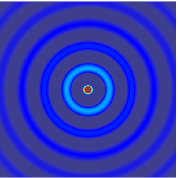Wave equation
Equations that describe waves as they occur in nature are called wave equations. Waves as they occur in rivers, lakes, and oceans are similar to those of sound and light. The problem of having to describe waves arises in fields like acoustics, electromagnetics, and fluid dynamics.
Historically, the problem of a vibrating string such as that of a musical instrument was studied by Jean le Rond d'Alembert, Leonhard Euler, Daniel Bernoulli, and Joseph-Louis Lagrange.[1][2][3][4] In 1746, d’Alambert discovered the one-dimensional wave equation, and within ten years Euler discovered the three-dimensional wave equation.[5]
Wave Equation Media
French scientist Jean-Baptiste le Rond d'Alembert discovered the wave equation in one space dimension.
Swiss mathematician and physicist Leonhard Euler (b. 1707) discovered the wave equation in three space dimensions.
References
- ↑ Cannon, John T.; Dostrovsky, Sigalia (1981). The evolution of dynamics, vibration theory from 1687 to 1742 (PDF). Studies in the History of Mathematics and Physical Sciences. Vol. 6. New York: Springer-Verlag. pp. ix + 184 pp. ISBN 0-3879-0626-6. Archived from the original (PDF) on 2016-12-29. Retrieved 2014-05-17.] GRAY, JW (July 1983). "BOOK REVIEWS". BULLETIN (New Series) OF THE AMERICAN MATHEMATICAL SOCIETY. 9 (1). (retrieved 13 Nov 2012).
- ↑ Gerard F Wheeler. The Vibrating String Controversy, (retrieved 13 Nov 2012). Am. J. Phys., 1987, v55, n1, p33-37.
- ↑ For a special collection of the 9 groundbreaking papers by the three authors, see First Appearance of the wave equation: D'Alembert, Leonhard Euler, Daniel Bernoulli. - the controversy about vibrating strings Archived 2020-02-09 at the Wayback Machine (retrieved 13 Nov 2012). Herman HJ Lynge and Son.
- ↑ For de Lagrange's contributions to the acoustic wave equation, can consult Acoustics: An Introduction to Its Physical Principles and Applications Allan D. Pierce, Acoustical Soc of America, 1989; page 18.(retrieved 9 Dec 2012)
- ↑ Speiser, David. Discovering the Principles of Mechanics 1600-1800, p. 191 (Basel: Birkhäuser, 2008).






